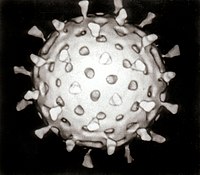
Photo from wikipedia
© 2020 Wolters Kluwer Health, Inc. All rights reserved. www.pidj.com | e289 Clinical Severity of Gastroenteritis in Children Hospitalized With Rotavirus Infection Before and Post Introduction of a National Rotavirus… Click to show full abstract
© 2020 Wolters Kluwer Health, Inc. All rights reserved. www.pidj.com | e289 Clinical Severity of Gastroenteritis in Children Hospitalized With Rotavirus Infection Before and Post Introduction of a National Rotavirus Vaccination Program in Australia 8.2%–20.4%]; among the latter, 13 of them and 2 outpatient children were followed collecting their paired specimens until both resulted negative 24 hours apart. Of the 300 paired specimens evaluated: 276 were concordant, 24 were discordant, so the naïve concordance was 92.0% (95% CI 88.3%–94.6%) with Cohen’s kappa (K) 0.63. Among the paired specimens whose NPA resulted positive, 41.9% (95% CI 28.2%–56.9%) had NS negative; while among the paired specimens whose NPA resulted negative, 2.3% (95% CI 1.1%– 5.1%) had NS positive. Considering NPA as the gold standard for detection of SARS-CoV-2, we calculated sensitivities and specificities of NS. The overall sensitivity of NS was 58.1% (95% CI 43.1%–71.8%) and the specificity was 97.7% (95% CI 94.9%–98.9%). Since the different practice in specimen collection, we divided our cohort according to the children’s age (<6 or ≥6 years, Table 1). Among children under 6 years, the concordance was K = 0.67. Regarding children of 6 years or older, the concordance was K = 0.60. The NS has, in any case, a low sensitivity in detecting SARS-CoV-2 in children when referred to NPA. Our results, the first we know are available, suggest to prefer the collection of NPA whenever possible for the detection of SARS-CoV-2 in children.
Journal Title: Pediatric Infectious Disease Journal
Year Published: 2020
Link to full text (if available)
Share on Social Media: Sign Up to like & get
recommendations!